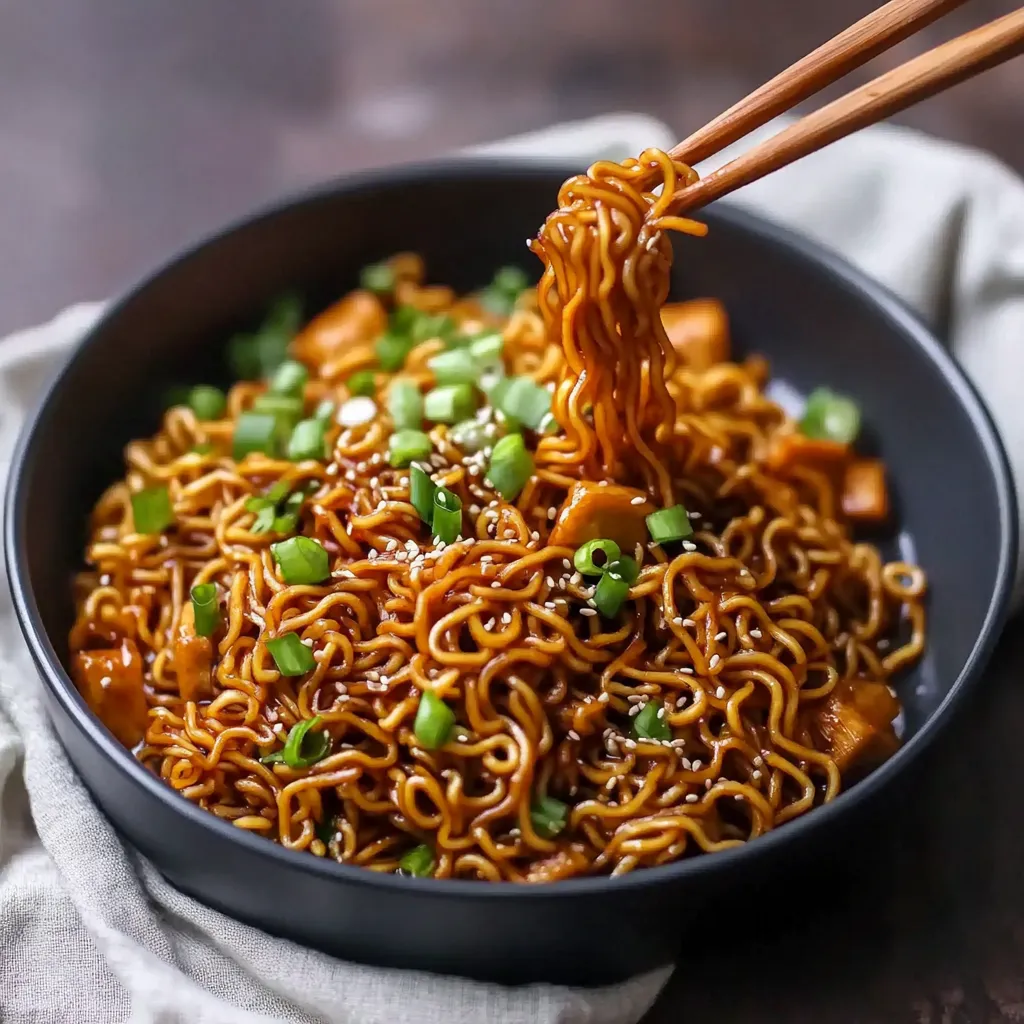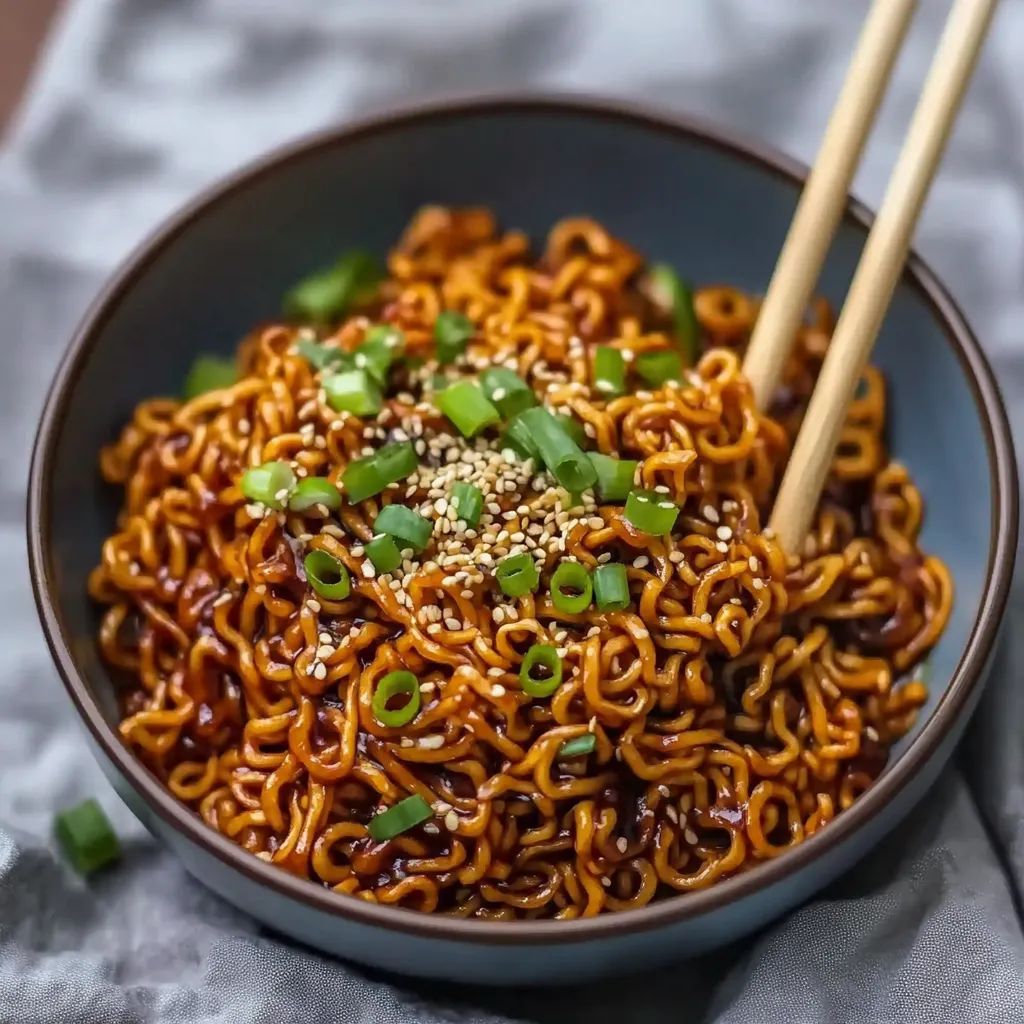 Bookmark
Bookmark
This saucy ramen noodle recipe transforms basic instant noodles into a restaurant-worthy meal in minutes. The perfectly balanced sauce clings to every strand, while your choice of protein and vegetables makes it endlessly customizable.
I created this recipe during a particularly busy week when takeout was tempting but my budget disagreed. Now it's become my go to meal when cravings hit but time is short.
Ingredients
- Ramen noodles instant cakes work perfectly but any Asian style noodle will do
- Extra firm tofu provides plant based protein that soaks up all the flavor
- Soy sauce forms the savory base of our sauce use low sodium if you prefer
- Corn starch transforms the liquid into a glossy sauce that clings to every bite
- Sugar balances the saltiness adding necessary depth rather than sweetness
- Rice vinegar brightens everything with subtle acidity
- Sesame oil delivers that authentic restaurant finish with just a small amount
- Chili garlic sauce optional but adds wonderful complexity beyond just heat
Step-by-Step Instructions
- Prepare the Sauce
- Mix water or vegetable broth with soy sauce corn starch sugar rice vinegar ground pepper chili garlic sauce sesame oil and minced garlic until completely smooth. The corn starch may resist incorporating at first but keep whisking until no lumps remain. This sauce is completely customizable so taste and adjust the seasonings to your preference.
- Partially Cook the Noodles
- Bring water to a rolling boil in a pot and add your noodles. Cook them for about 2 minutes less than package directions specify. They should still have a firm bite in the center as they will finish cooking in the sauce. Drain immediately to prevent them becoming mushy.
- Sauté the Protein and Vegetables
- Heat your pan over medium high heat until a drop of water sizzles on contact. Add just enough oil to coat the bottom and add your tofu or vegetables. Allow them to develop some color before stirring. Cook until they reach your desired tenderness but still retain some texture.
- Create the Sauce
- Give your sauce mixture another good stir to reincorporate any settled corn starch and pour it into the hot pan with your sautéed ingredients. The sauce will immediately begin to bubble and thicken. Stir constantly to prevent any sticking or burning. Watch as it transforms from watery to glossy in just about 3 minutes.
- Combine and Finish
- Add your partially cooked noodles directly to the thickened sauce. Use tongs to gently toss everything together ensuring each strand gets coated. The noodles will absorb some of the sauce as they finish cooking becoming infused with flavor. Continue cooking until the sauce reaches your desired consistency.
 Bookmark
Bookmark
The sauce proportions might seem high compared to the noodles but trust me this recipe is all about that saucy goodness. My family loves to spoon the extra sauce over rice the next day.
Make Ahead Options
This dish comes together so quickly that making it ahead isn't necessary but you can certainly prepare components in advance. The sauce mixture keeps well in the refrigerator for up to 3 days in a sealed container. Just give it a thorough shake before using as the corn starch will settle.
You can also prep all your vegetables and protein earlier in the day or even the night before. Store them separately in the refrigerator until ready to cook.
For meal prep purposes I recommend keeping the noodles and sauce separate until ready to eat. Cook the noodles just until al dente rinse with cold water and toss with a tiny bit of oil to prevent sticking. Store the sauce separately and combine just before serving with a quick reheat in a hot pan.
Flavor Variations
The beauty of this recipe lies in its adaptability. For a Korean inspired version add a tablespoon of gochujang paste to the sauce. For Japanese flavors incorporate a splash of mirin and use shiitake mushrooms.
You can make it creamy by adding a tablespoon of peanut butter or tahini to the sauce. Coconut milk makes another delicious addition replacing half the water for a Southeast Asian twist.
Protein options are endless from shrimp that cooks in minutes to leftover rotisserie chicken that just needs warming through. Vegetarians might enjoy fried tofu eggs or edamame for protein.
Serving Suggestions
These noodles are perfectly satisfying on their own but can be elevated with thoughtful garnishes. A sprinkle of toasted sesame seeds adds wonderful texture and visual appeal. Thinly sliced green onions provide freshness and color.
For a complete meal serve alongside simple steamed or roasted vegetables. A small side salad with a rice vinegar dressing makes a refreshing contrast to the rich noodles.
When entertaining serve these noodles family style in a large shallow bowl allowing guests to help themselves. Provide small bowls of additional garnishes like chopped cilantro lime wedges bean sprouts or crushed peanuts to customize each serving.
Recipe FAQs
- → Can I use different noodles instead of instant ramen?
Yes, you can substitute with any Asian-style noodles such as udon, soba, rice noodles, or even regular pasta. Just adjust the cooking time according to package instructions, making sure to undercook them slightly before adding to the sauce.
- → How can I make this dish vegan?
This dish is already vegan when made with vegetable broth and plant-based protein like tofu. Just ensure any pre-packaged noodles you use don't contain animal products.
- → What vegetables work best in this dish?
Bell peppers, broccoli, carrots, snap peas, bok choy, and mushrooms all work wonderfully. You can use one type or a combination based on your preferences. Pre-cook harder vegetables slightly longer to ensure they're tender.
- → Can I make the sauce less spicy?
Absolutely! The chili garlic sauce is optional. You can omit it entirely for a mild version or reduce the amount to control the heat level. The dish will still be flavorful from the other sauce ingredients.
- → How do I store leftovers?
Store cooled leftovers in an airtight container in the refrigerator for up to 3 days. When reheating, add a splash of water as the noodles tend to absorb the sauce when stored. Microwave or reheat in a pan until thoroughly hot.
- → What's the purpose of the cornstarch in the sauce?
Cornstarch acts as a thickening agent, creating that glossy, restaurant-style sauce that clings to the noodles. For a thinner sauce, reduce the amount; for a thicker sauce, increase it slightly.
